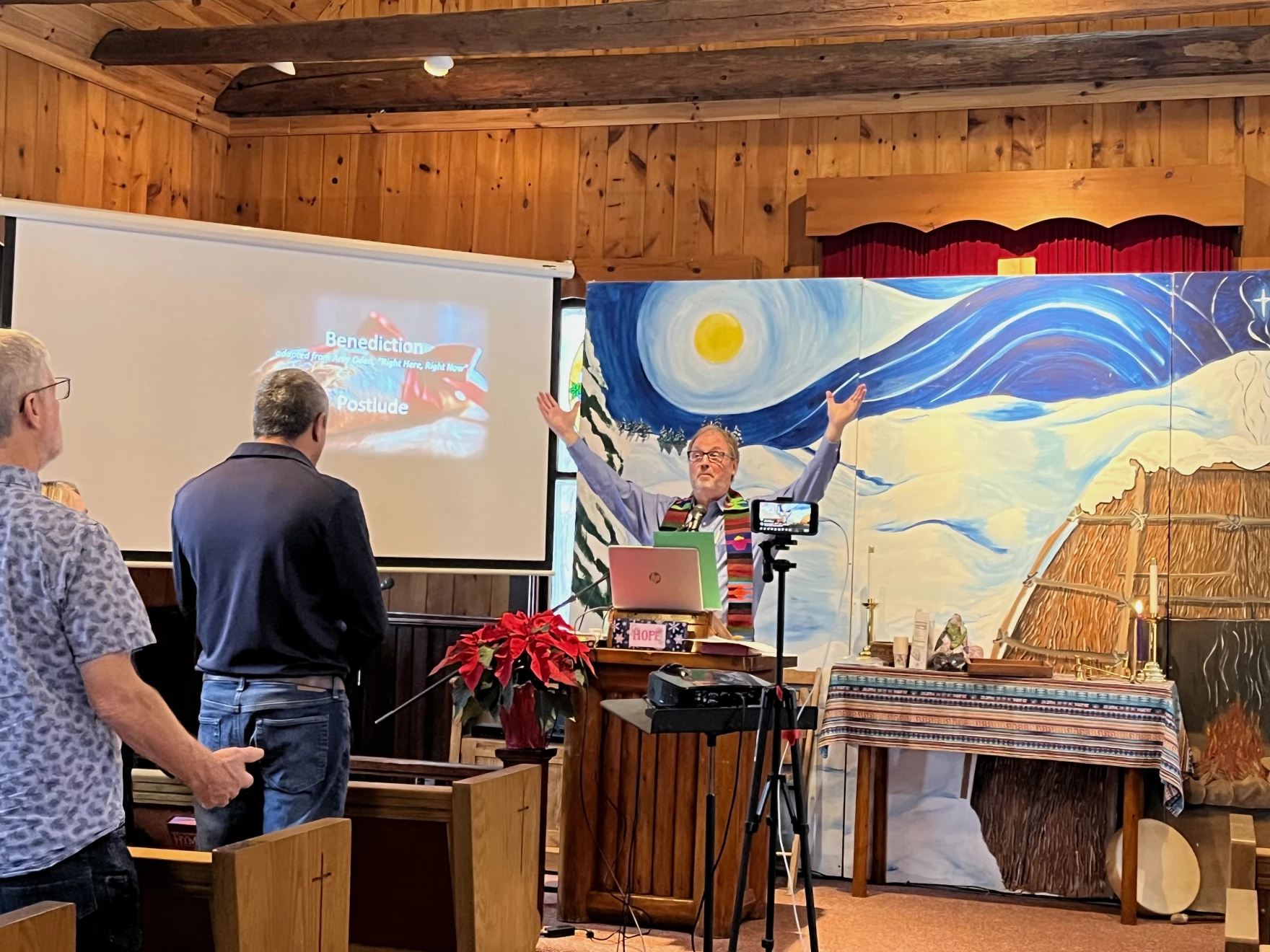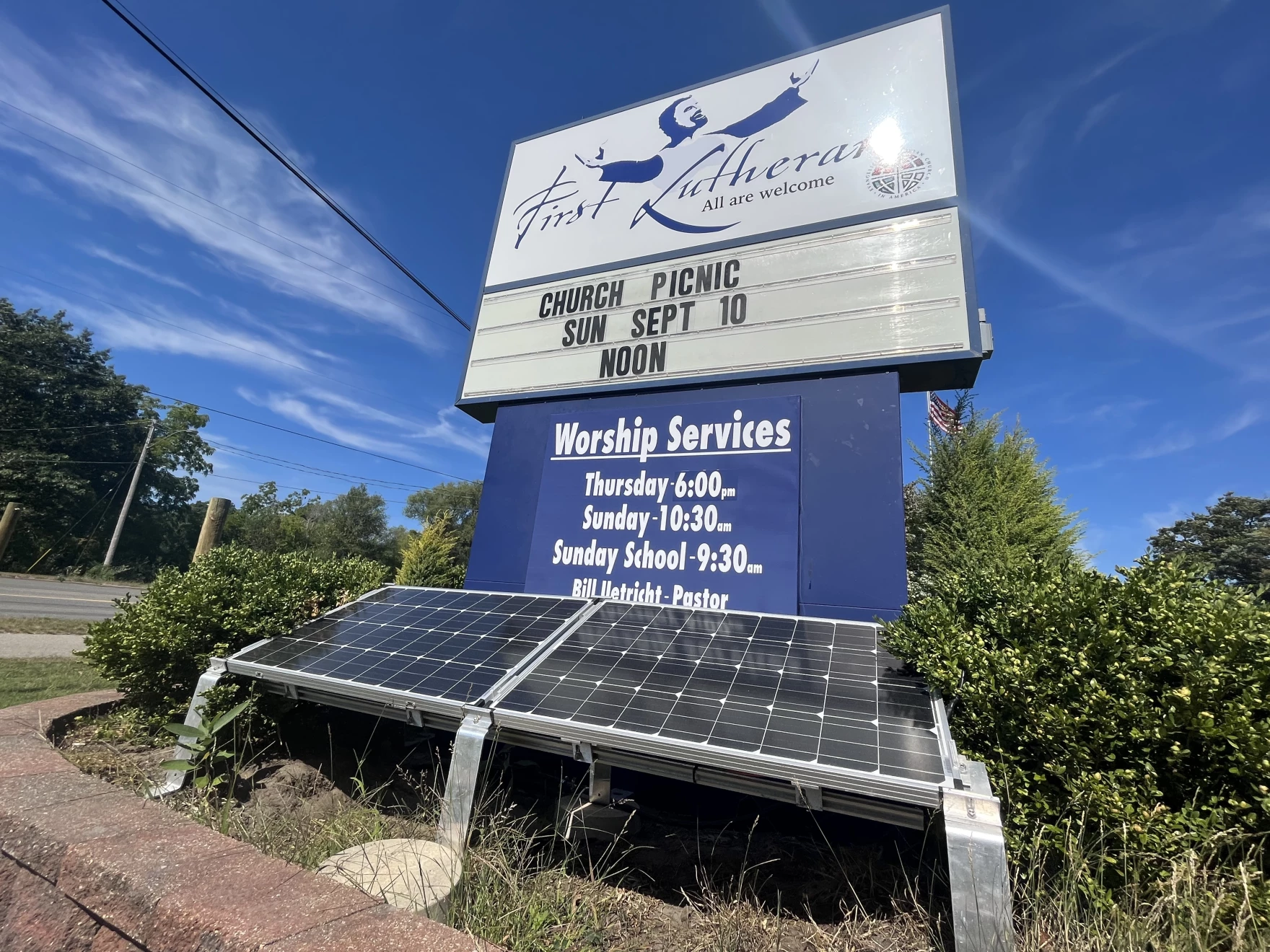
By Izzy Ross, Interlochen Public Radio
This coverage is made possible through a partnership with IPR and Grist, a nonprofit independent media organization dedicated to telling stories of climate solutions and a just future.
On a Sunday morning in Charlevoix, people gather in the small, one-room building of the Greensky Hill Indian United Methodist Church. They sing hymns in English and Anishinaabemowin.
At the pulpit, Pastor Jonathan Mays is leading the service. It’s one of his last — he’s since retired.
In between reflections on scripture, Mays touches on an important venture: The church is planning to install solar panels on their meeting hall.
Greensky Hill has a long history of environmental care and stewardship, grounded in Anishinaabe culture.
One of their priorities is the “greening of Greensky Hill.”
Mays said that prompts them to ask “how we can use our space and our resources to address those issues for climate care, or creation care, or what some people call Earth keeping.”
“The biggest issue was how can we get this huge building off of greenhouse gas creation?” he said in an interview. “How can we change from our present heating system, which is based on propane gas, liquid propane, in both the small church sanctuary and the large hall? And can we either get off the grid completely or contribute clean energy back to the grid?”
The church’s upcoming solar project is through Solar Faithful, a Michigan-based nonprofit group.
Across the country, houses of worship are pursuing these projects.
Paying for the project
The Berkeley Lab says about 2% of houses of worship in the United States have solar energy systems.
Compared to other non-residential buildings, that’s “disproportionately high,” according to Interfaith Power and Light.
But these projects can be difficult to finance.
Because houses of worship generally don’t pay taxes, they’ve had trouble capitalizing on renewable energy tax benefits.
Instead, they sometimes worked with third parties that could benefit from renewable energy tax credits. For instance, an investor would buy and install the array on a church, but the church wouldn’t own it, and would buy power from the investor — an arrangement called a power purchase agreement.
Now, that’s changing. The federal Inflation Reduction Act has made it possible for governments and nonprofits, including houses of worship, to get tax credits for renewable projects — called “direct pay” — which could help cover some costs. And advocates say it’s a critical part of getting more congregations to consider solar.
“I expect in the coming year, it’s really going to boom, the solar on houses of worship,” said Sarah Paulos, the program director for Interfaith Power and Light. “It makes a lot of sense. If they can cut their utility bill way back, then they have more money to do what they’re there for, which is their mission.”
Interfaith Power and Light might sound like a local utility (or maybe a prayer group) but it’s actually a national network focused on climate action and religion, started in 1998 as a coalition of Episcopal churches that worked together to buy renewable energy. It has since expanded to other denominations and faiths.
“In the public conversation I think we’ve kind of failed to see the leadership that people of faith and conscience are taking on these issues,” said Leah Wiste, the executive director Michigan Interfaith Power and Light.
Wiste said these kinds of projects rely on social connections.
In the early days of solar, Wiste said many of the congregations they worked with wanted to hear from others before pursuing projects. And she said they can be risk-averse.
“They don’t want to be the first to try something,” she said, “And they are collective stewards of resources, and they want to be really responsible.”

Solar panels sit outside the First Lutheran church in Muskegon. (Photo: Izzy Ross/IPR News)
People of faith have spoken out and taken action on environmental issues for decades. But the landscape and tenor of the discussion has drastically shifted, as more people have accepted that climate change is a reality.
Paulos, with Interfaith Power and Light, has worked in this field for almost 20 years. She said when she started, there were a lot of climate deniers, especially in churches, so it took resolve for people to speak out about those issues.
“In the beginning, people of faith were really, really being courageous and stepping out and talking about responding to climate change through renewable energy and energy efficiency as a moral call to care for creation,” she said.
Rob Rafson has worked to put solar panels on churches for more than a decade.
Rafson, who’s the president of the solar energy company Chart House Energy, wanted to focus on making it easier for houses of worship to adopt solar by financing and guiding those projects.
Solar Faithful was launched by Chart House Energy, the Climate Witness Project, Michigan Interfaith Power and Light, and an “interfaith group of climate activists” from the Detroit area, the website says. It also partners with World Renew, Sunwealth, and D2 Solar.
“It’s been a very big challenge,” he said. “Because churches — they’re nonprofits, they don’t have a budget, they don’t want to borrow money, and the size project, even though this is a fairly big one, is too small for investors to invest in.”

Pastor Bill Uetricht poses for a photograph at First Lutheran Church in Muskegon. The church has a solar array up and running. (Photo: Izzy Ross/IPR News)
Making it happen
But congregations still managed to get those projects up. At the First Lutheran Church in Muskegon, a new solar array shines on the roof.
“They’re hard to see,” said Pastor Bill Uetricht. He’s walking around the church, craning his neck, trying to get a good view of the panels.
“You have to really know what you’re looking for,” he said. “That’s where they’re located, and you can see that it’s on about half of that roof up there.”
The project means the church needs to buy less power from utilities. That’s expected to lower their energy bill.
It’s an example of a power purchase agreement. By purchasing the solar-powered energy, First Lutheran will pay off the project cost of around $175,000 to an investor. By buying the power from their own array, they’re slowly paying back their investor. Once that’s done, the power that comes from the array is essentially free.
Many people working at the intersection of religion and renewables say these projects are an opportunity for more people in those communities to learn about solar.
Uetricht said First Lutheran got involved with solar when a couple in the congregation gave the church two panels they didn’t know what to do with.
“I contacted a cousin of mine who works in alternative energy, and I said, ‘Hey, send me to someplace where I can do something with these two panels,’” Uetricht said.
They got in touch with Solar Faithful. While those two panels weren’t used in the array on the roof, they are placed out front by the church sign.
Uetricht said installing solar panels is one way of fulfilling their mission.
“What we say is that the world is not ours, that the world is a gift,” he said. “And if it’s a gift, then our call is to care for it, and it’s clear that we haven’t been caring for it very well. And old technologies have contributed to that lack of care. So it only makes sense that we would be at the forefront of encouraging alternative energy sources.”
Catch more news at Great Lakes Now:
Elk Rapids wants to help its shoreline through new state Climate Corps program
Michigan hopes community groups can get piece of $2B climate justice fund
Featured image: Pastor John Mays talks to his congregation at Greensky Hill Indian United Methodist Church in Charlevoix, in December. The church is working on getting a solar array up and running. (Photo: Izzy Ross, IPR News)



